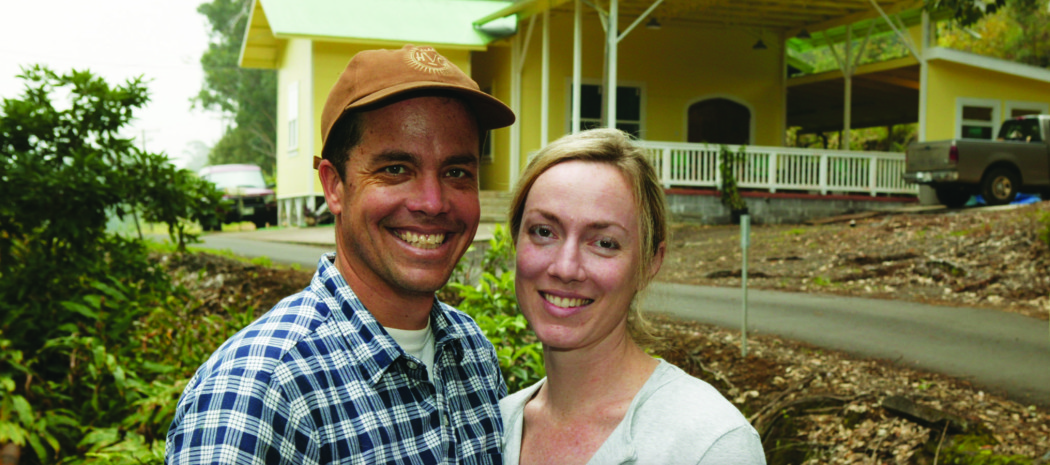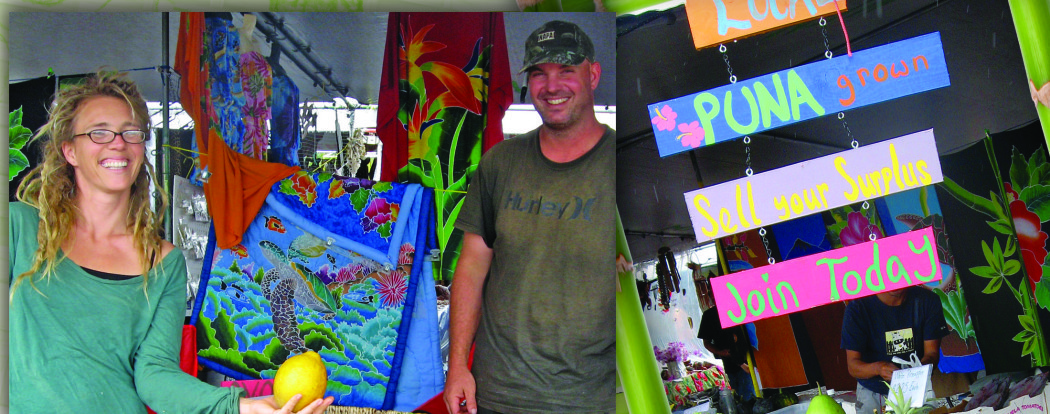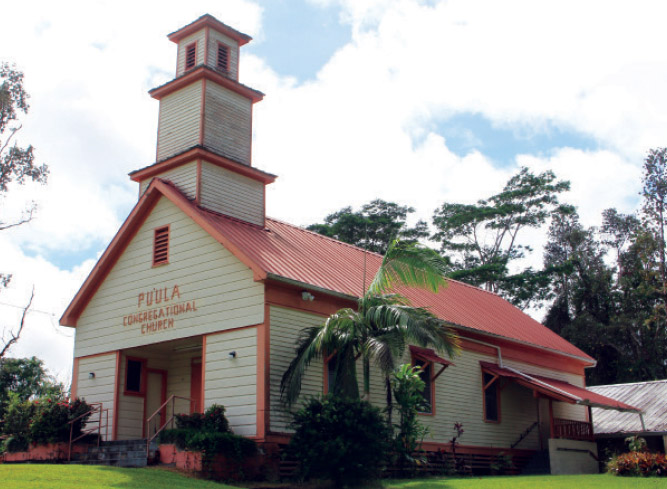
Strong in Spirit and Build: Puna’s Historic Congregational Churches

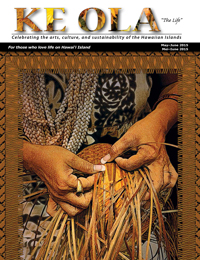
By Denise Laitinen
Puna residents are a hearty lot, known for their resiliency and ability to survive. So it should come as no surprise that their places of worship are equally strong, having withstood a myriad of natural disasters.
In some cases, historic churches in Puna have actually been moved or rebuilt (more than once!) as a result of Mother Nature.
“We’re used to disasters because our church was taken by lava 25 years ago,” says Kahu Mike Warren, of Kalapana Maunakea First Hawaiian Congregational Church, in Nānāwale Estates subdivision.
Kalapana Maunakea First Hawaiian Congregational Church, UCC
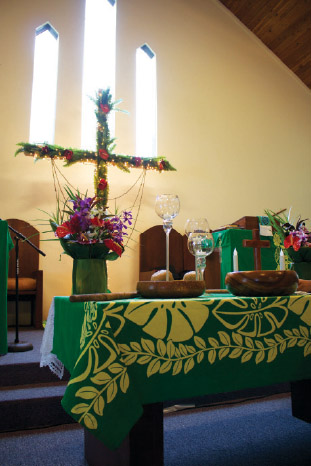
Perhaps no other church on the island has endured more than this small congregation composed of less than 100 members. The oldest congregational church in east Hawai‘i is even older than well-known Haili Church in Hilo.
Tucked deep in the lower Puna neighborhood, the unassuming blue church is off the beaten path of tourists. This hidden gem of a church is steeped in history and its musically inclined members have won awards from royalty.
“We’re in the fifth building of our church,” says Kahu Mike.
The first missionaries set foot on Hawai‘i Island in 1820 after arriving in Kailua-Kona from Boston aboard the ship, Thaddeus.
Kalapana Maunakea’s first church, made of pili grass, was built as a mission station after Reverend William Ellis and three missionaries visited Kaimū and Kalapana while travelling the island by foot in 1823. It’s reported that when the missionaries reached Kalapana in early August of that year they held worship services for 700 Hawaiians living in nearby villages.
After the mission station was hit by a tidal wave, the congregants moved the building further back from the shore and rebuilt it from lava rock.
In 1868, Hawai‘i Island experienced a catastrophic 7.9 magnitude earthquake and subsequent tsunami that killed 77 people. The two disasters devastated the Ka‘ū and Puna coasts, destroying most of the buildings in Kalapana, including the church.
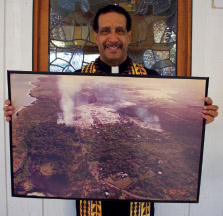
The congregation set about building a new church with building materials delivered from Honolulu by the steamer, “Kina‘u.” The strongest men in the community swam out to the boat with ropes tied around their waist.
“The Hawaiians swam the lumber in from the boats,” says Kahu Mike. The church, which was called “Kalauonaone” (many sands), was rebuilt within two years and featured a church bell from New York.
In the early 1900s, erosion along the Puna coastline caused the congregants to dismantle the church and rebuild it further inland on solid rock.
Lore has it that during the rebuilding process a church member painting the steeple saw Mauna Kea and cried out “Maunakea, Maunakea.” From then on, the church was called the Kalapana Maunakea Congregational Church.
In 1977, the church was threatened by lava, which stopped a mile and a half before reaching the church grounds. The church wasn’t as fortunate when lava approached Kalapana again in 1990, consuming the church in June of that year. In the weeks before the church was destroyed by fire from the lava flow, congregants removed the most precious items including a koa cross, the church bell, a silver flagon, and a silver chalice.
The flagon and chalice represent one of the church’s greatest accomplishments. In 1886, the church’s choir, 60 members strong, walked for three days from Kalapana to Hilo to participate in the Aha Mele, an annual statewide song contest at Haili Church. The Kalapana choir won first place and received the flagon and chalice with an inscription from Princess Lili‘uokalani.
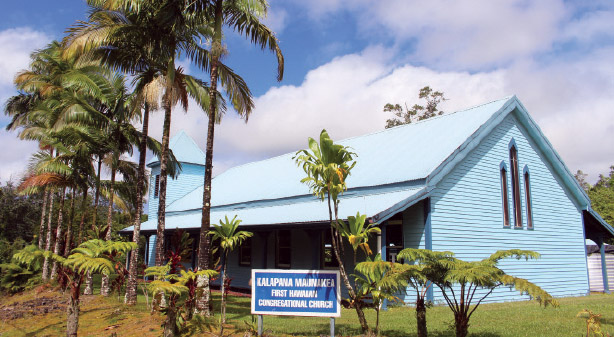
After the church burned in 1990, Pu‘ula Congregational Church in Nānāwale invited the church to use their facilities. In 1992, the church became part of the United Church of Christ (UCC), becoming officially known as the Kalapana Maunakea First Hawaiian Congregational Church, UCC. Church members decided to rebuild in Nānāwale on land given to them by the Nanawale Corporation, and their current church, the fifth in the congregation’s history, was completed in 1996.
Today, the majority of the church’s members are comprised of five Hawaiian families, many with deep ties to Kalapana. The church is active in the community, participating in a monthly feeding program with the Hawai‘i Island Food Basket and providing emergency food for area residents.
“We’ve always been feeding people,” says Kahu Mike. “When the missionaries stepped off the boat we fed them. We were the first church and we continue feeding people to this day.”
“We continue on,” says Kahu Mike. “The church continues to go on generation after generation. You see the kids here—they’re all from Kalapana.”
And indeed while the church is often referred to as the Hawaiian church, on any given Sunday you’ll find people of a variety of ethnicities and ages, running the gamut from infants to senior citizens, and even the occasional dog. It’s also a musical church with a band performing songs in English and Hawaiian. Kahu Mike plays ‘ukulele and sings.

Pu‘ula Congregational Church, UCC
Pu‘ula Church, just up the road from Kalapana Maunakea Church in Nānāwale, has also weathered its share of challenges.
Pu‘ula, (red conch shell), was first established in Koa‘e (near Kapoho) by missionaries in 1839. Originally a thatched hut, the church was replaced with a wooden building in 1850 with a bell tower added in 1868.

In a span of little more than a month in 1960, a volcanic eruption destroyed the town of Kapoho. The church was one of the few buildings left standing, but it was surrounded by lava. For nearly a decade, the congregation was unable to use the church.
“Many Kapoho residents had moved to Nānāwale and often commented how nice it would be if their church could be up in their new neighborhood too,” says Pastor Diane Hultman.
“Around 1968–1969, a crew of guys went down to Kapoho and decided to move the church. They had to cut it in half because the roads were narrow. At the time, there were five lots in Nānāwale set aside for churches. Pu‘ula is on one, Kalapana Maunakea is on another,” adds Pastor Diane, continuing, “It took about a year to rebuild the church, and we had our first service here in Nānāwale on Easter Sunday 1970.”
Pastor Diane says the church currently has roughly 35 members, about half of whom live in Nānāwale while the rest live in Puna. Some of the members have been attending the parish for decades and include a mixture of ethnicities ranging from families with young children to senior citizens. A potluck meal is held after the weekly service in the social hall next to the church that was built in 1971 (and rebuilt after a 1991 fire).
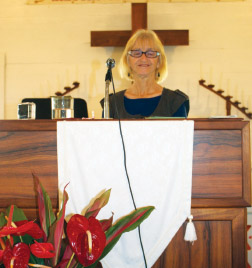
Even though the parish is small, Pastor Diane says they offer a wide variety of services, including a monthly young people program for roughly two dozen high school students, a recovery center group that meets with a counselor during the week, and a transition house.
“We’re an involved church,” says Pastor Diane, “a real community minded congregation.”
They also know how to deal with adversity. Although the church itself was not damaged in the storm, Nānāwale was among the hardest hit community by Hurricane Iselle last August, during which time the neighborhood was without power and water for more than two weeks.
So it is probably no surprise that the congregants are steadfast about remaining in their community now that lava from the June 27 Kīlauea flow is threatening Pāhoa.
Pastor Diane says that as the lava approached Pāhoa last year, she asked the congregation if they planned to stay if the lava crossed Highway 130 and all their hands went up. She asked how many would stay if the lava crossed Railroad Avenue and all their hands went up. She then asked how many would stay if lava crossed Beach Road, and again all raised their hands.
“Then one of the parishioners said, ‘there’s only one problem pastor, we didn’t see your hand go up,’” says Pastor Diane with a chuckle. A Nānāwale resident herself—Diane and her husband live near the church—Diane has lived in Hawai‘i for 31 years. She said up until that time, she wasn’t sure if she would stay or go, but after that sermon, she decided to stay.
“We have church members that are fishermen, who know how to live off the land; we’ll survive.”
Pastor Diane and Kahu Mike were among the nearly 100 Puna residents and clergy who attended a multi-faith prayer service in downtown Pāhoa in September 2014 when the smoke plume from the lava flow was looming large over the town. Both ministers point out that the lava slowed the day after that service.
‘Opihikao Congregational Church, UCC
‘Opihikao Congregational Church, nestled along the Puna coastline on Kapoho-Kalapana Road, is unlike the other Puna congregational churches in that it has not had to relocate due to disasters. However, the church is steeped in history with one local family figuring prominently for more than five generations.
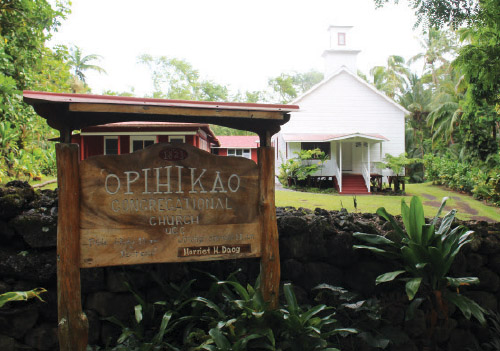
After Reverend William Ellis and a group of missionaries visited Kalapana and Kaimū in August 1823, they continued travelling by foot along the Puna coastline, arriving in ‘Opihikao a few days later. There, they were welcomed at the home of Kalaikoa, a community leader. It’s not known when the church was built, but it’s believed to be originally sited at Kalaikoa’s home.
In 1853, Daniel Makuakane became the leader of the church and was conveyed the title of Reverend in 1865 after growing the church’s congregation to 319 members. Rev. Daniel Makuakane was known as the “kanaka kahu hipa o ke kuahiwi” or “the shepherd from the back country.”
Records indicate that the church was rebuilt in 1895, but it’s unclear why and if that was the second or third rebuilding of the church. After Rev. Daniel Makuakane passed away, the church was without a full-time pastor for decades.
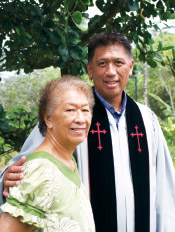
“There were many, many pastors that served the church,” says Reverend Violet Makuakane. But my husband was the first-full time minister since his great-great-grandfather Daniel Makuakane.”
John P.C. Makuakane, Rev. Daniel Makuakane’s great-great-grandson, was born and raised in ‘Opihikao and grew up next door to the church. He was appointed deacon of ‘Opihikao Church in 1959 even though he did not have the formal training of a minister. In the United Church of Christ, ordained ministers go through specific training and keep the title of Reverend even after they retire. Whereas licensed ministers have to get relicensed every year and cannot keep their title.
Seeing a need for more ministers across Hawai‘i Island in 1985, John’s wife Violet requested that the Conference Board of Directors for the State Council of Hawaiian Congregational Churches create a formal training program for ministers in east Hawai‘i.
After graduating the first ministers’ training class, John became Reverend Makuakane in 1987. He continued serving as minister until his death in 2006, at which time Violet, who also became an ordained minister, took over the reigns until she retired in 2009. Today, services are held by Kahu Harriet Daog, a licensed minister who is the niece of Rev. John Makuakane. ❖
Kalapana Maunakea Church is located at 14-3502 Kahoolawe Rd., Pāhoa in Nānāwale Estates. Sunday services are held at 10:45am.
Pu‘ula Congregational Church is located at the intersection of Kehau Rd. and Church Rd. in Nānāwale Estates. Sunday services are held at 9:30am.
‘Opihikao Congregational Church is located at 13-6325 Kapoho-Kalapana Road in ‘Opihikao. Bible study is every Sunday at 10am, with worship service at 11am.
